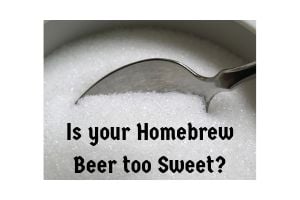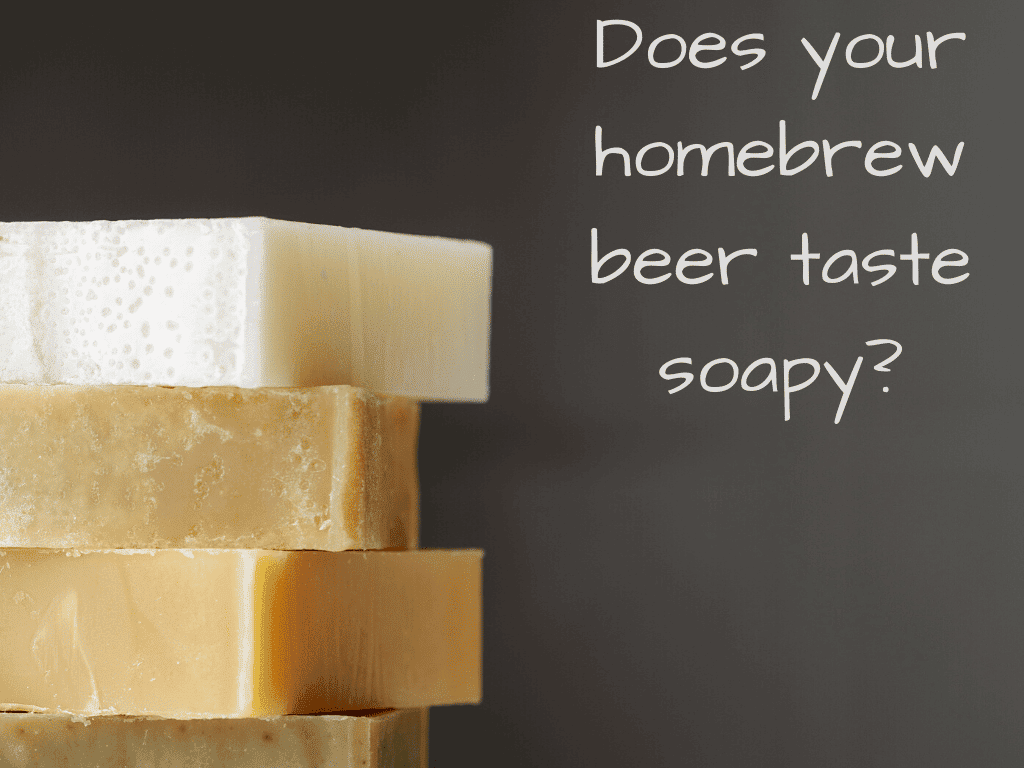Many people enjoy the flavor of bananas but banana flavor in beer is not always desirable. Since I’ve run into this particular off-flavor before while homebrewing I thought it would be a good idea to explain what causes this flavor to develop and how to prevent it.
Banana flavor in homebrew beer comes from the Isoamyl acetate ester (a combination of an acid and alcohol molecule) that is produced during the fermentation of all beers to some degree. Too much isoamyl acetate in beer is normally caused by high fermentation temperatures or stressed yeast and can be considered an off-flavor.
It is important to realize that some styles of beer actually depend on having banana as part of their flavor profile, but it isn’t considered appropriate for all styles. Extremely high levels can also produce a nail polish-like flavor that is highly undesirable.
Topics We Cover
What causes a banana flavor in homebrew beer?
The fermentation of beer is an incredibly complex process that relies on many variables to achieve the desired outcome. In most cases, off-flavors that develop in your beer will be the result of something going wrong with the fermentation stage whether it be the yeast itself, the temperature, or something else.
In the case of banana-like flavors in your beer, it all comes down to the Isoamyl acetate compound which is found in naturally high levels inside the banana plant. This compound is formed when isoamyl alcohol and acetic acid combine to form a new molecule which is more generally defined as an ester. If you have ever purchased artificial banana flavoring, it is essentially just isoamyl acetate dissolved in ethanol.
Now that we know precisely what is causing that flavor, let’s figure out how it got there in the first place!
Fermentation always produces esters such as isoamyl acetate
We normally think of alcohol and carbon dioxide as the products of the fermentation process, but many people might not realize that there are tons of other compounds produced during this highly intense process including various acid and alcohol molecules.
These molecules combine together to form what is known as an ester and they are present in all beer to some degree although more or less of them will be produced depending on the strain of yeast used, the temperature of the fermentation, and the length of conditioning. Esters often have a fruity taste and aroma with notes of bananas, pears, anise, rose, or even bubblegum. In high enough concentrations, these esters can take on a heavy, solvent-like flavor that is highly undesirable.
With that said, it isn’t necessarily that we are trying to avoid esters and estery flavors altogether, but rather we need to focus on making sure that we get the right amount of esters for the style of beer that we are brewing.
Typically, you will start to notice a banana-like flavor once you get up to about 1.4 mg of isoamyl acetate per liter of beer.
So, which beer styles benefit from this flavor? Let’s see!
Banana flavor is an important flavor in some beer styles
While many off-flavors are obviously bad, such as plastic, metal, or astringency, a banana-like flavor doesn’t necessarily sound that bad on the surface.
Beer styles such as Bavarian Hefeweizens, in fact, are basically a showcase for this particular flavor compound and great care goes into the recipe and yeast selection for these beers to produce the desired flavor without going overboard. Belgian yeasts, in general, will tend to produce more of these estery flavors with all other variables being equal.
There are many beer styles that incorporate bright and yeasty flavor elements that include notes of banana. You could find subtle banana flavors in the following styles to some degree:
- Hefeweizen
- Kristalweizen
- Witbier
- Belgian Blond Ale
- Belgian Golden Strong Ale
- Belgian Tripel
- Belgian Strong Pale Ale
- Saison
- Gruit Ale
This is by no means an exhaustive list. Plus, there are endless ways to experiment with beer and it is totally possible to add more or less banana flavor just by changing up yeast strains and fermenting temperatures.
Now that we know all about where the banana flavor comes from, let’s see what we can do to prevent it from becoming overpowering in our beers (unless we want it to be!).
How to avoid banana flavor in beer when homebrewing
Compared to other off-flavors, banana flavors aren’t too difficult to deal with in most cases. Since the flavor compounds responsible for it are highly dependent on yeast strain and temperature, we will know where to start our journey.
To avoid banana flavors in your beer you should select a yeast strain with a clean flavor profile and high attenuation, ferment at the lower end of the ideal temperature range, and consider leaving your beer in the primary fermenter a little longer or add a secondary fermentation stage.
Some of this advice is easier said than done, especially the fermentation temps, but this is what it will take to ensure that you get a cleaner flavor with your beer. I know I say this often, but the temperature of your fermentation is one of the single biggest variables that you need to be able to control in order to make great-tasting beer!
Banana flavor will often decrease over time with aging
One bit of good news if you have already brewed a beer that has an annoying banana flavor is that this is one of the off-flavors that will likely decrease over time.
If you taste banana flavors while the beer is still in the primary fermenter then consider leaving it there longer or moving it into a secondary fermenter for a little more conditioning to lessen the flavor. If your beer is already bottled, simply leave it in a cool place for a while to let it bottle condition.
Like most homebrew problems, a little patience can go a long way towards fixing it. Many times I have heard homebrewers say that they wished they had just given a beer more time before they drank it all.
This means leaving your beer in the primary fermenter longer, adding a secondary fermentation stage, or simply bottle-conditioning your beer for a month or two before you start chilling and serving. Aging and conditioning are not an exact science so it will probably be worthwhile to have a plan to taste test your beers at certain stages of bottle conditioning until you get the flavor that you are looking for and you can chill the whole batch.
Wouldn’t you rather have a delicious homebrew a few months down the road than a mediocre one next week? Just run to the store and grab a case to hold you over! Or, brew more often!
Choose a yeast strain with a cleaner flavor profile
I mentioned earlier that certain strains of yeast will produce more estery flavors. To minimize banana-flavored esters, choose a yeast strain with a cleaner flavor profile. It is also worth noting that ale yeasts will typically produce more esters than lager yeasts.
Here is a selection of yeast strains from White Labs, Wyeast, and others that will give you a good idea of what to choose for your next beer. Other providers will likely have similar strains to these.
- WHITE LABS AMERICAN HEFEWEIZEN ALE 320
- WHITE LABS HEFEWEIZEN ALE 300
- WHITE LABS HEFEWEIZEN IV ALE 380
- WYEAST BAVARIAN WHEAT 3638
- WYEAST CANADIAN/BELGIAN ALE 3864-PC
- WYEAST GERMAN WHEAT 3333
- WYEAST WEIHENSTEPHAN WEIZEN 3068
- MANGROVE JACK BAVARIAN WHEAT
- LALLEMAND MUNICH (GERMAN WHEAT BEER)
- BREWFERM LAGER
Each of these strains will produce varying levels of esters, including the isoamyl acetate that gives beer it’s banana-like flavor. In some case, the yeast should even be underpitched to provide more of this flavor.
Ensure that your yeast is healthy
While some yeast are meant to produce more esters, even yeast strains that aren’t known for this can produce more esters than usual if the yeast is stressed.
Yeast can become stressed fairly easily and while it is impossible to completely remove all stressors, it is definitely possible to minimize them. Here are some best practices for keeping your yeast healthy:
- Avoid repitching yeast from previous batches of beer too often.
- Aerate your wort well before pitching yeast to enable faster reproduction.
- Keep temperatures stable within two degrees during fermentation.
- Ferment on the lower end of the temperature range.
- Use specialty yeast for high-gravity beers.
- Use a yeast starter prepared before primary fermentation begins.
With those basics in line, you shouldn’t have to worry as much about your yeast overproducing esters during fermentation.
Control the temperature of your fermentation
I’ve already mentioned that temperature plays a huge role in the overall success of your fermentation and final flavor profile.
In general, fermenting at the higher end of a given yeast’s temperature range will result in higher ester production. For reference, here are the temperature ranges for the three common categories of yeast:
- Belgian – 65 to 80+ °F
- Ales – 55 to 75 °F
- Lagers – 35 to 55 °F
Most homebrewers are going to be using basic ale yeasts because they are the most common and easiest temperature range to work in without special equipment. Most people can cool a room down to 70 degrees and use a couple of tricks such as a water bath, ice packs, towels, and fans to cool their fermenter down even further.
For the web story version of this article click here!




